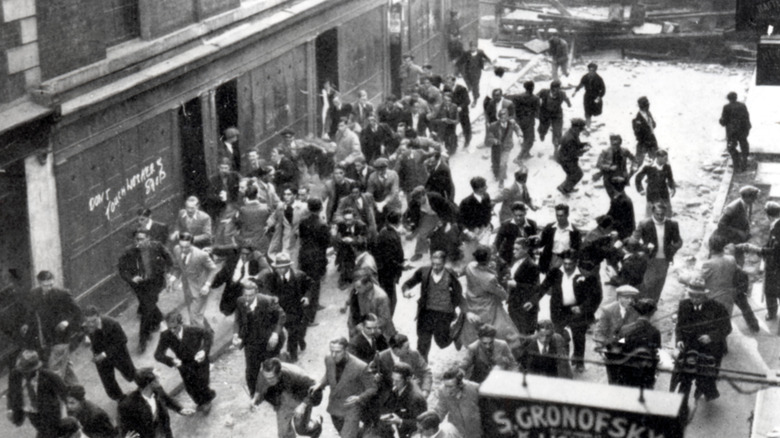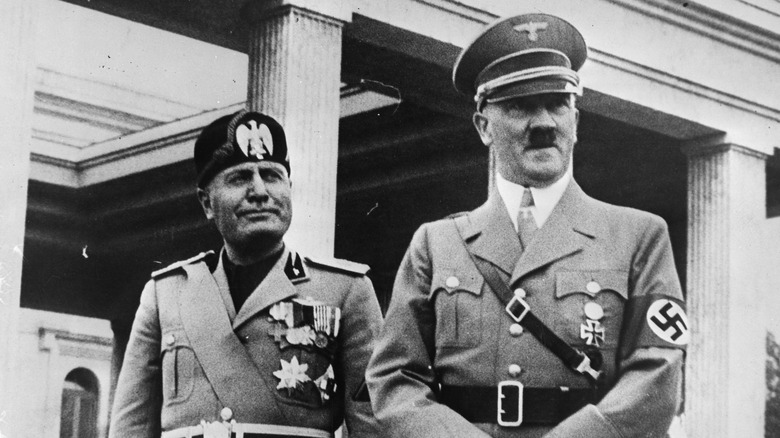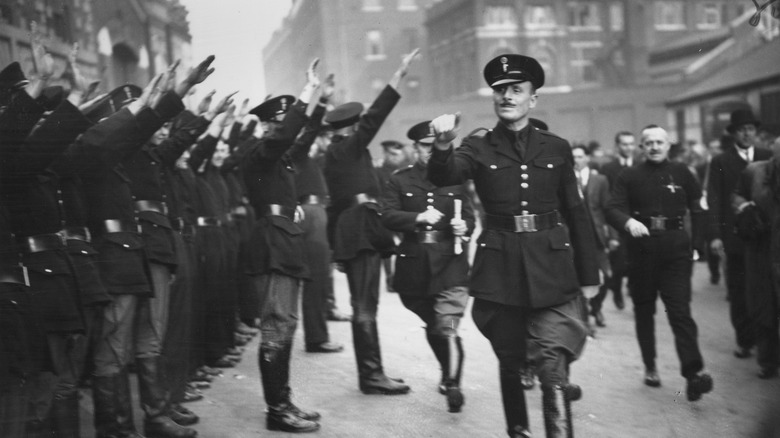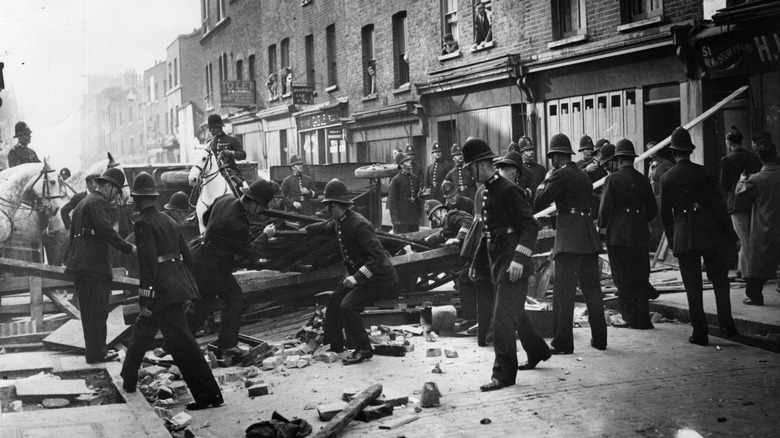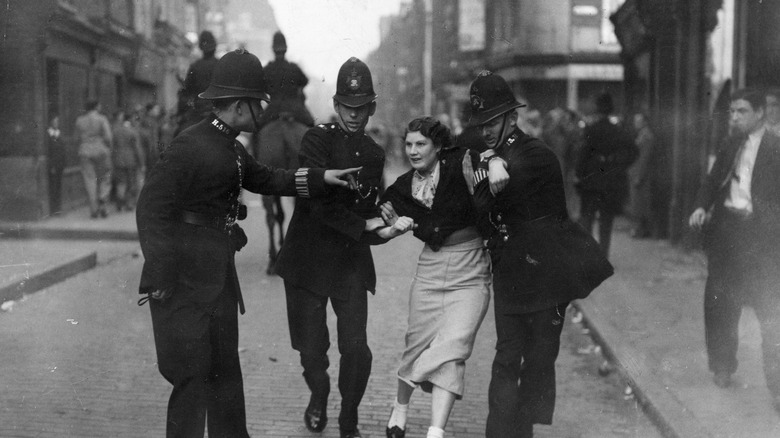How The Battle Of Cable Street Changed England's Fascist Movement
The fascism movement that swept through Europe in the 1920s and 1930s has been very well documented. According to the University of Pittsburgh, it began with Benito Mussolini starting the Fascist Party in 1919, and by the middle of the next decade he was the self-appointed dictator. Fascism then became the word used to describe similar movements like Hitler's Nazi Party in Germany and the Nationalists of Francisco Franco. They all shared some common characteristics like an authoritarian dictator who spewed an ideology that one national or ethnic group was superior to the rest.
The spread of fascism was one of the major factors that plunged the planet into World War II. However, it's easy to overlook that these three were far from the only fascist movements that took place around this time. They make up part of the handful that grew powerful enough to take over an entire nation's government. Even the United Kingdom wasn't immune from a fascist movement, which wound up causing a series of street fights including the infamous Battle of Cable Street (via Historic UK).
The rise of fascism caused changes across Europe
As fascist leaders came to power in Italy, Germany, and Romania, there was a domino effect across the rest of the continent. Political instability was rampant and as some fled the situations in their home countries, others — typically members of left-wing or communist movements — attempted to fight back. In London, many Jewish refugees took up residence in the city's East End. According to Historic UK, the district of Stepney, in particular, became one of London's poorest and most densely-populated areas. Unfortunately, the influx of refugees also came at a time when anti-semitism was increasing all across Europe.
According to Britannica, Sir Oswald Mosley served in the House of Commons from 1918 until 1931. During that time he served as a Conservative, a member of the Labour Party, and even an independent. Mosley lost reelection in 1931 after trying to start a new socialist party, but the next year he started a new organization, the British Union of Fascists. Mosley quickly amassed a following due in large part to his public speaking ability, and a stamp of approval from newspaper publisher Harold Sidney Harmsworth, 1st Viscount Rothermere.
Mosley and the Blackshirts
The same year he started the British Union of Fascists, Mosley met the man who kicked off the surge in Fascism across Europe: Benito Mussolini. According to Express, the two developed a rapport and Mosley started to model himself after the Italian dictator. Mosley quickly amassed a following that he claimed was as large as 50,000, and he continued to advocate for authoritarianism and nationalism and was fiercely anti-communist.
Soon, Mosley took a page out of the Mussolini playbook and started his own paramilitary organization called the Blackshirts. According to Historic UK, Mosley got the idea from Mussolini's paramilitary group, the Squadrismo. At its peak, the Blackshirts had as many as 15,000 members. The group quickly became as well known for their violent tendencies as they were for their black shirts. One of the most notable instances of violence happened In 1934, when members of the Blackshirts attacked a left-wing Daily Worker. However, as the fascist ranks grew, so too did their opposition, and soon the two groups were on a collision course for a battle on the streets of London.
The Battle of Cable Street
Mosley announced plans for a march into the heart of London's East End. The march — scheduled for October 4, 1936 — immediately caused concern as the Blackshirts would be marching into a part of the city that was home to many Jewish residents, and it seemed like their intent was to cause some sort of trouble (via Historic UK). Ahead of the march, the Blackshirts distributed antisemitic leaflets around the East End. Despite the Jewish People's Council presenting a petition with 100,000 signatures to try to ban the march, the Blackshirts had the support of the media and the police so it went on as planned.
The Communist Party canceled another event that was scheduled for October 4 and ushered members over to the East End. Other groups sent members to block the blackshirts as well. However, thousands of police officers attempted to clear a path for them into Whitechapel but failed due to the counter-marchers and several trollies parked in the way. Mosley sent his followers down Cable Street, a narrow road that ran parallel to the original route.
However, this had been anticipated by the anti-fascists and residents, who littered the road with glass and marbles and blocked it. Rotten fruit and boiling water were dumped from windows overlooking the street and soon fights broke out.
The aftermath
Ultimately, 79 of the left-wing members were arrested, and just 6 Blackshirts. However, celebrations still broke out across the city as antifascists' efforts led to Mosley and the Blackshirts turning around and retreating. The next year, the Public Order Act of 1937 was passed. The act prohibited people from wearing political uniforms in public, which was a direct result of what happened on Cable Street.
According to Historic UK, there were more Blackshirt-related incidents of violence in the years that followed, but the incident on Cable Street caused a negative shift in the public's perception of the group. An even greater negative light was shined on the Blackshirts after the outbreak of World War II, and in 1940, Mosley and other Blackshirt leaders were sent to prison. The British Union of Fascists fell apart after his imprisonment, but Mosley went on to lead the Union Movement which was the BUF's successor. He led the Union Movement from 1948 until his death in 1980 (via Britannica).
Many of the people that stood in the way of the Blackshirts that day in 1946 continued in their efforts to fight the spread of fascism in Europe. Many gave money or volunteered to join the International Brigade in Spain. In 1976, Mexican artist Diego Rivera was commissioned to paint a mural on the side of the St. George Town Hall that depicts the Battle of Cable Street.
